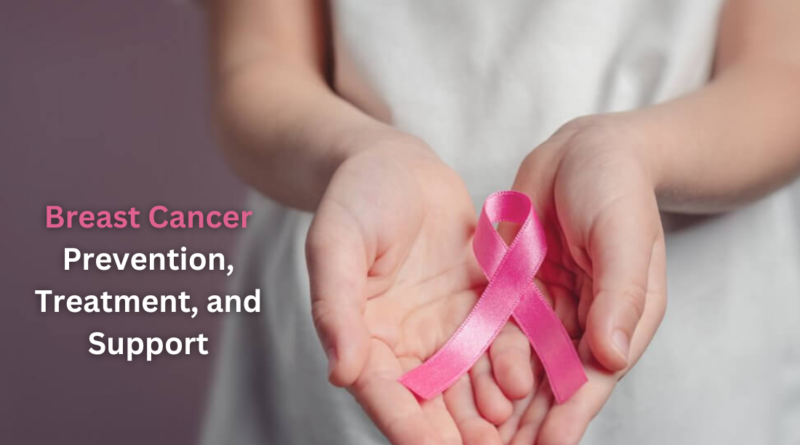Breast Cancer: Prevention, Treatment, and Support
Breast cancer is one of the most common cancers among women worldwide, but the good news is that advances in prevention, early detection, and treatment have improved survival rates significantly. Whether you’re looking to lower your risk, understand treatment options, or support someone going through it, this guide covers everything you need to know. Breast Cancer involves early detection, lifestyle changes, and medical interventions to manage the disease effectively. Medications like Mamofen, a commonly prescribed treatment, play a vital role in helping patients treat breast cancer by blocking hormone activity linked to tumor growth.
Understanding Breast Cancer
Breast cancer begins when cells in the breast grow uncontrollably, often forming a tumor that can spread to surrounding tissues. While it primarily affects women, men can develop breast cancer too, albeit rarely.
These cancers commonly originate in the milk ducts (ductal carcinoma) or lobules (lobular carcinoma). Over time, untreated cancer may spread to other parts of the body, a process known as metastasis.
Common Types of Breast Cancer
Breast cancer isn’t a one-size-fits-all disease. Some common types include:
- Ductal Carcinoma In Situ (DCIS): A non-invasive form confined to the milk ducts.
- Invasive Ductal Carcinoma (IDC): The most common type, spreading beyond the ducts.
- Triple-Negative Breast Cancer (TNBC): An aggressive form lacking common receptors for treatment.
- HER2-Positive Breast Cancer: Caused by excess HER2 protein.
Understanding these distinctions helps tailor the most effective treatment plan.
Key Risk Factors
Some risk factors are beyond control, like age, family history, or genetic mutations (e.g., BRCA1 and BRCA2). However, lifestyle factors, including diet, physical activity, and alcohol consumption, also play a role. Women who start menstruation early or experience menopause late may face an increased risk due to prolonged exposure to estrogen.
Antreol, a medication often used to treat breast cancer, is effective but requires careful consideration of key risk factors such as age, hormone receptor status, and overall health to ensure the best outcomes for patients.
Preventing Breast Cancer
Lifestyle Changes to Lower Risk
While not all breast cancer cases are preventable, adopting a healthy lifestyle can significantly reduce your risk:
- Maintain a Healthy Weight: Obesity increases risk, especially after menopause.
- Exercise Regularly: Aim for at least 150 minutes of moderate aerobic activity weekly.
- Limit Alcohol: Even small amounts can raise risk, so moderation is key.
- Avoid Tobacco: Smoking is linked to numerous cancers, including breast cancer.
The Role of Regular Screenings
Mammograms are a cornerstone of early detection. Women aged 40 and above should consult their doctors about regular screenings, as early-stage cancer is more treatable. Clinical breast exams and self-examinations also empower individuals to detect unusual changes.
Genetic Testing and Preventative Care
Women with a family history of breast cancer should discuss genetic testing for BRCA mutations. Preventative measures, including lifestyle adjustments or prophylactic surgeries, may be considered for those at high risk.
Recognizing the Signs and Symptoms
Early Warning Signs of Breast Cancer
The earlier breast cancer is detected, the better the prognosis. Watch for:
- A lump in the breast or armpit.
- Changes in breast size, shape, or symmetry.
- Unusual nipple discharge.
- Dimpling or puckering of breast skin.
- Persistent pain in the breast area.
When to Consult a Doctor
Don’t ignore persistent symptoms, even if they seem minor. Schedule a consultation with your doctor if you notice changes in your breasts that don’t go away.
Understanding Diagnostic Tests
Doctors may recommend several tests to confirm a diagnosis:
- Mammogram: X-ray imaging to identify abnormalities.
- Ultrasound or MRI: For detailed images of breast tissue.
- Biopsy: Extracting a small sample of tissue for laboratory testing.
These tests provide critical information about the cancer’s type, stage, and spread.
Treatment Options for Breast Cancer
Surgical Treatments
Surgery is often the first step in treatment:
- Lumpectomy: Removes the tumor while preserving the breast.
- Mastectomy: Removes the entire breast to eliminate cancer cells.
- Reconstructive Surgery: Restores breast appearance post-treatment.
Radiation Therapy and Chemotherapy
- Radiation Therapy: Targets and destroys cancer cells in specific areas.
- Chemotherapy: Uses drugs to eliminate cancer cells throughout the body. This approach is often employed for aggressive or advanced cancers.
Hormonal and Targeted Therapies
Hormone-sensitive cancers respond to drugs that block estrogen or progesterone. Targeted therapies focus on specific cancer cell mechanisms, such as HER2 proteins, offering precision in treatment with fewer side effects.
Emotional and Physical Support During Treatment
Managing Side Effects of Treatment
Treatments can bring side effects like fatigue, nausea, or hair loss. Strategies include:
- Anti-nausea medication for chemotherapy-induced sickness.
- Scalp cooling caps to reduce hair loss.
- Rest and hydration to combat fatigue.
The Importance of Emotional Well-being
A cancer diagnosis can take an emotional toll. Consider:
- Seeking therapy or counseling.
- Practicing mindfulness and meditation.
- Engaging in hobbies to stay positive and focused.
Building a Support Network
Support from loved ones or joining cancer support groups can make a huge difference. Sharing your experiences with others who understand can provide comfort and encouragement.
Life After Breast Cancer
Recovery and Rehabilitation
The road to recovery involves physical and emotional healing. Physical therapy can help regain mobility post-surgery, while counseling supports mental health.
Monitoring for Recurrence
Regular follow-ups are crucial to detect recurrence early. Annual mammograms and blood tests may be recommended by your doctor.
Embracing a Healthier Lifestyle
Post-cancer life offers an opportunity to adopt healthier habits. A balanced diet, exercise, and stress management can improve long-term outcomes and quality of life.
Conclusion
Breast cancer is a challenging journey, but with early detection, effective treatment, and a strong support system, it’s a battle many can win. From prevention to recovery, taking proactive steps can make all the difference. Remember, no one fights alone—reach out for help and resources to navigate this path with confidence.




